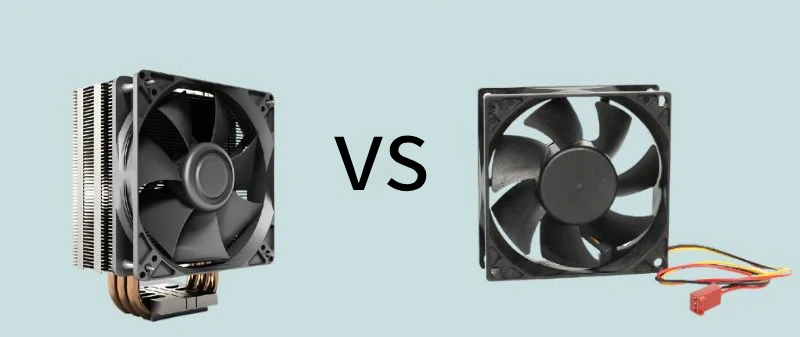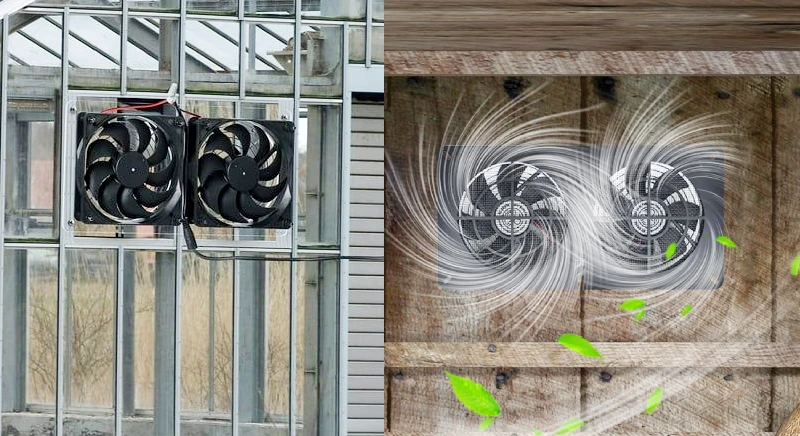You might wonder about the difference between a chassis fan vs CPU fan. A chassis fan helps with overall cooling inside your computer case, while a CPU fan focuses on cooling your processor. You’ll see three main types of cooling fans in desktop systems:
- Axial fans
- Centrifugal fans
- Crossflow fans
Choosing the right cooling matters for stable performance. Linkwell’s Computer Chassis Fan gives you reliable cooling and keeps your system running smoothly. The Chassis Fan vs CPU Fan question often comes up when you want to boost cooling efficiency.
Key Takeaways
- Chassis fans improve overall airflow in your computer case. They pull cool air in and push warm air out, keeping all components at safe temperatures.
- CPU fans are essential for cooling the processor. They pull heat away from the CPU and work with a cooler to prevent overheating, which can damage your system.
- Using both chassis and CPU fans together provides the best cooling solution. This combination ensures stable temperatures and optimal performance for your computer.
Chassis Fan vs CPU Fan

Chassis Fan Definition
When you look inside your computer, you will see fans attached to the case. These are called chassis fans. A chassis fan sits inside the computer case and helps move air in and out. Its main job is to pull cool air into the case and push warm air out. This keeps all your computer parts at a safe temperature. You can find chassis fans in different spots, like the back, front, or top of the case.
Here’s a quick look at where you might install a chassis fan:
| Location | Fan Size Options | Notes |
|---|---|---|
| Rear | 1 x 140mm | Usually a single exhaust fan. |
| Front | Up to 3 x 120mm or 2 x 140mm | May need to remove the ODD cage. |
| Top | Up to 3 x 120mm or 2 x 140mm | Adds extra airflow options. |
If you want a high-performance option, Linkwell’s Computer Chassis Fan stands out. It offers strong airflow, low noise, and easy installation. You can use it for bulk orders or custom projects, making it a smart choice for both home and business setups.
CPU Fan Definition
A cpu fan works differently from a chassis fan. You will find the cpu fan sitting right on top of the processor. Its main job is to keep the CPU cool. The cpu fan pulls heat away from the processor and pushes it through a cooler, usually a metal heatsink. This helps prevent your CPU from getting too hot, which can slow down your computer or even cause damage.
Here’s how the cpu fan compares to other fans in your system:
| Fan Type | Function | Location |
|---|---|---|
| CPU Fan | Moves heat away from the CPU with the help of a cooler. | Mounted directly on the CPU |
| Case Fan | Circulates air for overall cooling inside the chassis. | Installed in the computer case |
| GPU Fan | Keeps the graphics card cool. | Attached to the GPU |
The cpu fan is a key part of your computer’s cooler setup. Without it, your processor could overheat quickly.
Key Differences
When you compare chassis fan vs cpu fan, you will notice some important differences. Both play a big role in keeping your computer cool, but they do it in different ways.
- Placement and Purpose
- The chassis fan sits in the case and manages airflow inside chassis. It keeps all the parts cool by moving air through the whole system.
- The cpu fan sits on the processor and focuses on cooling just the CPU. It works with a cooler to pull heat away from the chip.
- Airflow and Static Pressure
- Chassis fans are built for maximum airflow. They move a lot of air in and out of the case, which helps with intake and exhaust.
- Cpu fans are designed for high static pressure. This means they can push air through tight spaces, like the fins of a cooler or heatsink.
- The airflow rates (measured in CFM) and RPM ratings help you understand how much air each fan can move.
- Performance Table
| Feature | High-Performance Chassis Fans | CPU Fans |
|---|---|---|
| Airflow | High | Moderate |
| Static Pressure (mmH₂O) | Lower | Higher |
| Noise Level (dBA) | 20-30 (quiet) | 20-30 (quiet) |
- Noise Levels
- Both fans can run quietly. Most fans, including Linkwell’s Computer Chassis Fan, stay in the 20-30 dB range. This is quiet enough for most rooms and offices.
- Role in Cooling
- The chassis fan vs cpu fan debate comes down to their roles. The chassis fan keeps the whole system cool by managing airflow inside chassis. The cpu fan focuses on the processor, working with a cooler to keep it safe.
Tip: If you want the best cooling, use both types of fans. The chassis fan keeps the air moving, while the cpu fan and its cooler handle the hottest part of your system.
When you choose a fan, think about what you need. If you want to improve airflow inside chassis, go for a high-quality chassis fan like the one from Linkwell. If your processor runs hot, make sure your cpu fan and cooler are up to the task. The right balance between chassis fan vs cpu fan will keep your computer running smoothly and quietly.
Choosing the Right Fan for Your System

Installation and Compatibility
When you pick a system fan, you want to make sure it fits your setup. Start by checking your motherboard. For a cpu fan, look at the CPU socket type. Make sure the mounting bracket matches your socket, like Intel LGA or AMD AM4. You also need enough fan headers on your motherboard for the cpu cooler and system fan. Some motherboards let you control fan speed with PWM, which helps you keep things quiet or cool as needed.
For a chassis fan, check the size and mounting holes in your case. Linkwell’s Computer Chassis Fan makes installation easy with universal mounting. You can choose the right size and voltage for your system. If you run a business, bulk orders help you save money and keep your stock steady.
Tip: Always double-check compatibility before you buy a new system fan or cpu cooler. This saves you time and trouble later.
When to Use a Chassis Fan
You should use a chassis fan when you want better airflow inside your case. If you have high-performance parts, like a gaming GPU, you need more air intake and exhaust. Multiple chassis fans help keep your system fan setup balanced. This means cooler temperatures for your CPU and GPU. Linkwell’s Computer Chassis Fan gives you strong airflow and low noise, perfect for workstations or gaming rigs.
- More chassis fans mean better thermal control.
- You get steady temperatures, even during heavy use.
- Bulk buying helps IT teams and small businesses keep systems running without delays.
| Feature | Description |
|---|---|
| Size | Pick the right fit for your case |
| Voltage | Choose what matches your system |
| Color | Match your brand or style |
| Design | Custom options for special needs |
When to Use a CPU Fan
A cpu fan is a must for every system fan setup. If you run heavy workloads, like gaming or video editing, your cpu cooler keeps the processor safe. When your CPU gets hot, a good cpu fan keeps temperatures under 85°C. If you skip a cpu fan, your CPU can overheat in seconds. That can cause damage fast. Always use a cpu cooler with your processor, even for short tests.
- Use a cpu fan if your CPU temps go over 80°C.
- Never run a high-performance CPU without a cpu cooler.
- The cpu fan works with your system fan to keep everything stable.
| Feature | CPU Fan | Chassis Fan |
|---|---|---|
| Speed Control | Regulated by BIOS based on CPU temperature | Usually runs at a fixed speed |
| Fan Type | Usually 4-pin, can be compatible with 3-pin | Often 3-pin or 4-pin |
| Installation Control | Linked to temperature sensors for dynamic control | May need manual adjustment |
| Use Case | Optimized for CPU cooling during high loads | General airflow management in the case |
Note: For the best thermal results, use both a cpu fan and a chassis fan. This combo keeps your system fan setup balanced and your computer running cool.
You now know the difference between a CPU fan and a case fan. A case fan moves air through your system, while a CPU fan cools your processor. Choose a case fan that fits your needs. Linkwell’s case fan offers a 1-year warranty and top reliability.
| Warranty Duration | Coverage Details |
|---|---|
| 1 year | Free parts replacement and repair coverage |
Keep your case fan clean and check for dust. New case fan designs use smart sensors and adjust speed for better cooling. Picking the right case fan helps your system last longer and run better.
- Linkwell Electric has a perfect rating of 5.0.
- 100% on-time delivery.
FAQ
What happens if you don’t use a chassis fan?
Your computer can overheat. Parts may slow down or even fail. You’ll notice higher temperatures and maybe more noise from other fans working harder.
Can you use a CPU fan as a chassis fan?
No, you can’t swap them. CPU fans fit on the processor’s cooler. Chassis fans mount to the case. Each has a different design and purpose.
How often should you clean your chassis fan?
You should check your fan every few months. Dust can build up fast. Use compressed air or a soft brush to keep airflow strong.




